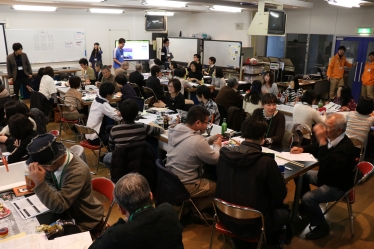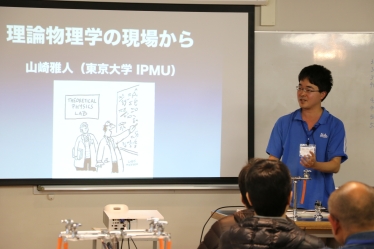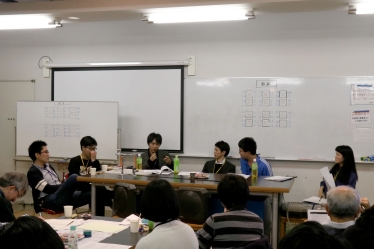Kavli IPMU Cohosts Workshop Exploring the Intersection between Art, Science and Philosophy

Date of activity: March 25, 2017
On March 25, members of the public packed into a lab at the Tamarokuto Science Center to learn and discuss the similarities and differences between art, science and philosophy. Plenty of discussion time was set aside after each talk to give participants time to discuss and exchange ideas.
“Searching for the Lost Study – Art×Science×Philosophy” featured talks from five experts - Kavli IPMU Assistant Professor and physicist Masahito Yamazaki, Kyoto Universityʼs Hakubi Project/Graduate School of Letters Assistant Professor and mathematical philosophy expert Yoshihiro Maruyama, neurotechnology research developer ARAYAʼs Manager and cognitive science expert Masafumi Oizumi, University of Tokyo Assistant Professor and aesthetics expert Shunsuke Kuwahara, and Art Center Ongoing Director Nozomu Ogawa. This was the second time the Kavli IPMU had hosted such a workshop.
About 40 people, half of them women, crowded around tables inside the science museum as they listened to Yoshihiro Maruyama give the opening talk of the day. Maruyama opened with the question: “If we say ‘lost study’, what’s lost and what’s wrong?” He invited the audience to think about the birth and development of knowledge from a logical perspective. How much of the basics of Science, of Mathematics, and of language is reliable, how can several kinds of knowledge be combined into one, and how much can we know about the world?
Next, Kavli IPMU Project Assistant Professor Masahito Yamazaki started his talk by presenting physics as an enterprise to pursue simple and universal fundamental laws explaining a vast variety of phenomena in Nature. He then introduced his cutting-edge research on extra dimensions, and along the way illustrated how a physicist works on a research problem on a daily basis. Yamazaki argued that physics provides an excellent prototype for problem solving: a deep and endless exploration of very basic questions leads us to common knowledge universal to all.
In the last science talk of the day, Masafumi Oizumi introduced us to a relatively new field of science: Integrated Information Theory (IIT) - an attempt to explain what consciousness is by using information theory and mathematics. He showed us the difficulties of scientifically studying consciousness, which doesn’t have any physical mass but still is obviously there, say “subjectively”, and invited the audience to think about the challenges.
Following a lunch break, participants came back to listen to speakers in the afternoon Art session.
The first speaker, Shunsuke Kuwahara, ran through the history of Aesthetics from 18th century Baumgarten’s “the science of sensible cognition”, to the 21st century’s Meillassoux, Harman, and Rancière. He suggested that the 17th century extension of the concept of Truth, during which aesthetical truth began to be included, led to Aesthetics. Kuwahara invited the audience to think about what the logic of sense could be.
Finally, Nozomu Ogawa claimed that for him, artwork is something more than words. It can be said that modern artwork is rated not by how deeply it questions but how valid its concept and/or context is. He showed a video by Francis Alÿs as one of his favorite experiences of art, and invited the audience to think of how art, which is now facing difficulties such as limitations in the market and institutional issues, can pose more universal or principle questions to society.
After both the Science session and Art session, short discussions were held and all speakers from each session exchanged their impressions of each other’s talks.
After all the talks, the speakers exchanged their points of view. They uncovered several connections between Art and Science, and challenges, including the difficulties of Art—sharing something that is more than words—were pointed out. The Q&A session that followed prompted questions such as, “How can Science appeal to more people?” and “Is there any way to share something more than words?” to which the speakers gave their opinions.
Throughout the day, the sound of people chattering echoed throughout the room as participants at each table discussed the questions given to them by the speakers.

A room full of participants exchanging ideas with each other 
Kavli IPMU Project Assistant Professor Masahito Yamazaki showed his point of view on physics 
Specialists from Art, Science and Philosophy found unexpected points in common






